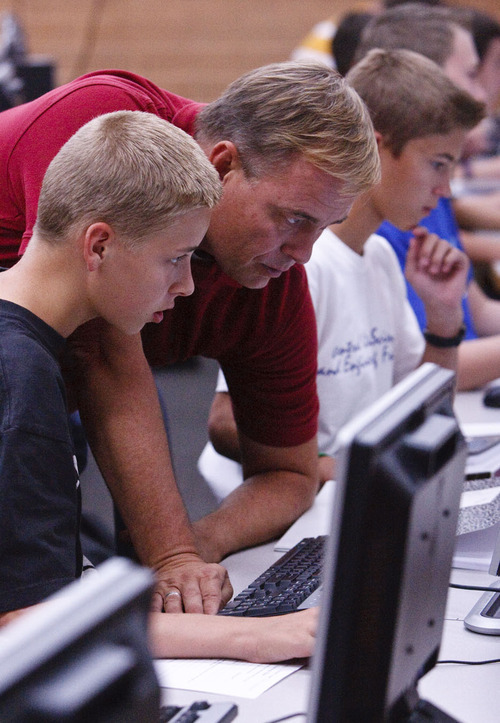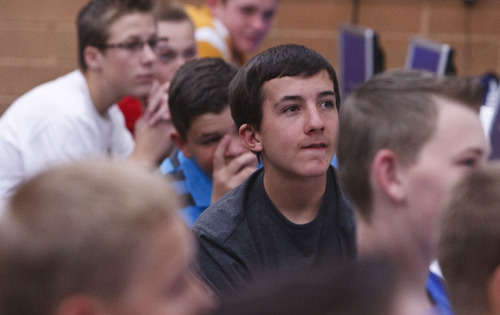This is an archived article that was published on sltrib.com in 2012, and information in the article may be outdated. It is provided only for personal research purposes and may not be reprinted.
Michael Corbett recently began a computer class he teaches with an unusual request: Step away from the computers.
His Lehi Junior High students instead walked in teams to the front of the room, where they presented their findings from a project in which they interviewed family and friends about their technology needs and researched which computers would fit them.
The lesson was a new approach for Corbett.
"I think they're learning more about really what makes up a computer," Corbett said, "because of what they're having to find out rather than me saying, 'This is a computer. This is what the parts are and this is what they do.' "
Corbett is one of several Utah teachers this year piloting a new way of teaching computer science that could soon explode in the state thanks to a $790,000 grant awarded to Westminster College by the National Science Foundation. The idea behind the project is that these days, teens know how to use computers, tablets and smartphones, but many aren't interested in the technical intricacies of how the devices work. Too few are taking advanced computer science classes, preparing for jobs in that growing field.
To fix that, Helen Hu, an associate professor of computer science at Westminster, has been directing a project with the State Office of Education and several Utah universities to implement a new, more hands-on class called Exploring Computer Science in Utah. She and others hope the rigorous approach will help get more Utah teens, especially girls and minorities, interested in the topic.
Instead of simply teaching kids how to program computers, students will learn how to understand problems, how to break problems into smaller, solvable steps and how to test solutions. Teens will explore questions and quandaries, Hu said. They'll discuss and reflect.
She and other project leaders hope to train 100 more Utah teachers in how to teach the class over the next three years. That would be enough to offer it at nearly half of Utah schools with ninth grades.
"It's important to actually engage the students and get them excited about the area because not enough of them are finding it exciting the way we're teaching it, the old way," Hu said. "There's so much more in computer science than learning how to communicate with the computer, and because we [normally] teach that in the first class, we sometimes scare away students."
It's unfortunate so many students are scared away, Hu said, because it's a field where job opportunities are actually growing.
"I do get more job postings from companies than I have students," she said. "Long after my last graduate student has found a job I'm still getting emails in the spring from companies desperate to hire."
Nicole Reitz-Larsen, who will also pilot the curriculum at Salt Lake City's West High this school year, said she's looking forward to encouraging her students to work in groups, write in journals and explain concepts to their peers.
She won't start officially teaching the curriculum until January, but already she said she has started integrating some elements into her classes.
"If you just tell the kids the answer, they memorize it and forget it, but if they have to come up with the answer themselves they'll internalize it better," she said of the new approach.
Carl Lyman, a specialist over information technology education at the state office, said the class teaches the types of 21st century skills that are just as important as the computer-science material itself.
It's a curriculum that has already been tried with some success in places such as Los Angeles and Chicago, Hu said. In the Los Angeles Unified School District, the program has grown steadily in recent years, and last school year, participation among boys was only about 30 percent higher than among girls.
It may still seem like a large gap, but that's far more girls than in many other types of computer science classes. Hu said she's sometimes the only female in the room in her upper-level classes.
Even Corbett said he often has only one girl in his classes at a time. In his new Exploring Computer Science class about six of Corbett's 33 students are girls. Computer technology is a high school graduation requirement in Utah, but more advanced classes are optional.
Annie Estes, 14, said the new class appealed to her because it sounded more interesting than typical computer technology classes.
"I just didn't want to feel so bored in class so I took this, so I could have a challenge," said Estes, a ninth-grader.
Other students said the class has also defied their expectations.
"I think it's a cool new way of doing a boring class," said Gavin Fowler, 14, who aspires to one day become a computer programmer like his dad. "It's been interesting. I've really enjoyed it."
Nathan Witt, 14, said the class has been challenging, but in a good way.
"It's, like, hard work," Witt said, "but we're doing fun stuff."
Twitter: @lschencker —
Interested in seeing the class at your school?
Parents interested in seeing the new Exploring Computer Science class in their schools should contact their schools Career and Technical Education directors. Teacher and administrators interested in adding the class next school year can contact Helen Hu at Hhu@westminstercollege.edu or Carl Lyman at carl.lyman@schools.utah.gov.









